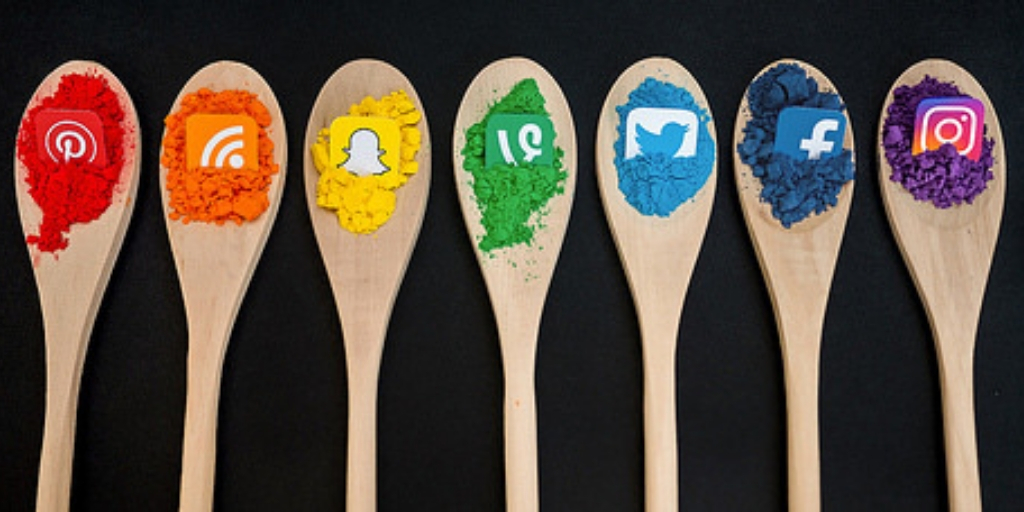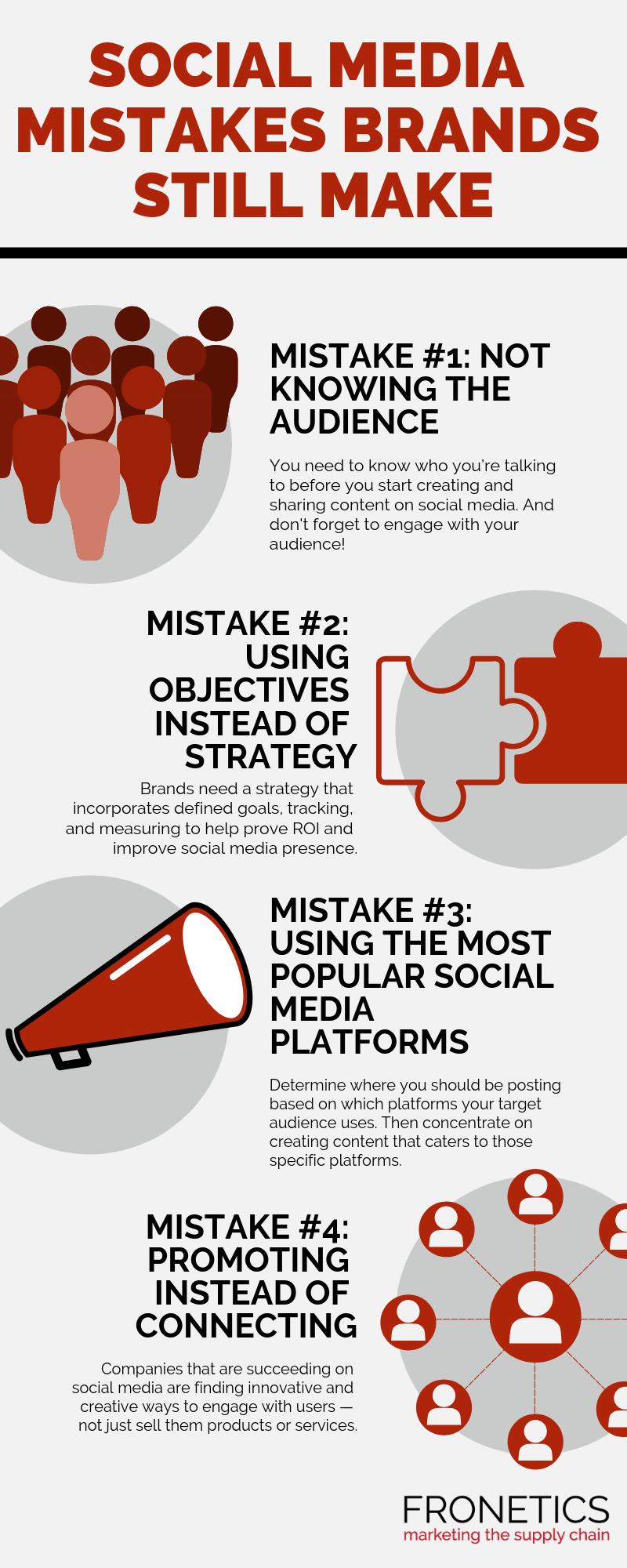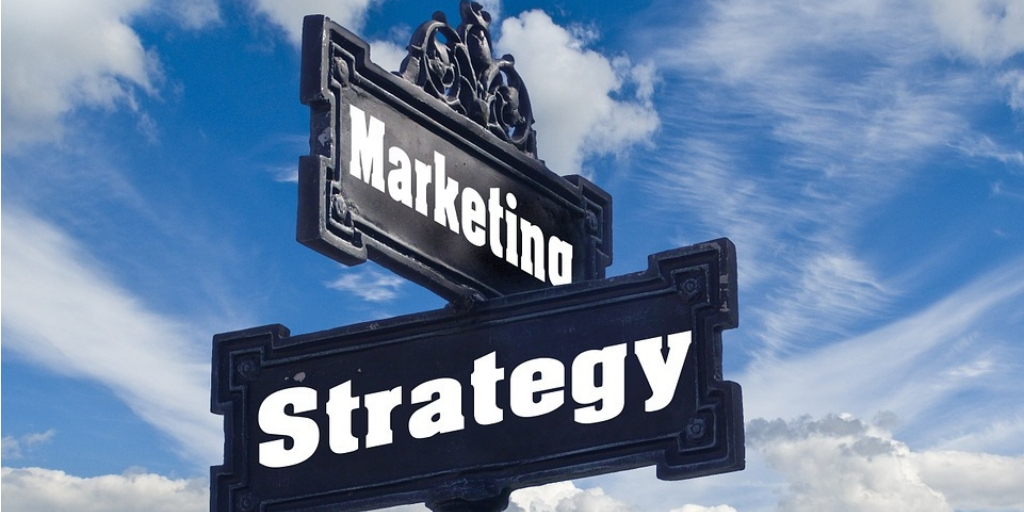
by Fronetics | Mar 13, 2019 | Blog, Marketing, Social Media
New reports show an overall decline in social media use. With dropping numbers, why should businesses continue to use social media use? Here’s seven reasons why your brand still needs social media.
Highlights:
- Social media usage has seen a steady decline in usage over the past two years.
- Having a presence on social media shows that your business is current, approachable, and interested in meeting their customers where they are. In fact, it is often more noticeable when a business does NOT have social media accounts than when they do.
- Success should be determined when a marketing strategy delivers against business goals, where social media is a part of the overall strategy. It is a classic case of the whole being greater than the sum of the parts.
Marketers have been speaking anecdotally about the decline of social media for a solid year, but now we have data to support our instincts. The Infinite Dial 2018 report, which explores consumer usage of media and technology, has found that for the first time ever, both Facebook and Twitter use declined in 2018, from 67% to 62% and 23% to 21%, respectively. Overall, social media usage has decreased from 80% in 2017 to 77% in 2018. To put that in perspective, social media usage has increased an average of 7.77% over the last 9 years. Experts predict that we will likely see continued decline in 2019.
So, given those statistics and predictions, why should businesses continue to use social media? In a saturated market with declining audience interest, what’s the point?
Here are seven reasons why social media is still worth your time and effort
1. It’s expected.
Much like consumers expect any company worth doing business with to have a well-thought out, updated, user-friendly website, they also expect to be able to find them on social media. Having a presence on social media shows that your business is current, approachable, and interested in meeting their customers where they are. In fact, it is often more noticeable when a business does NOT have social media accounts than when they do.
2. It’s a branding tool.
Social media allows consumers who otherwise wouldn’t know about your business to discover it and learn what it’s all about. Consistently publishing to social media results in your brand remaining top of mind when a potential buyer is looking for your product or services.
3. It’s a way to build authority.
Social media isn’t just a way to tell consumers about your brand; it’s a way to show your audience that you know what they care about, what resonates with them, and that you are a trusted source of information.
4. It boosts organic visibility.
The keywords used in social media and the backlinks acquired send signals to search engines that your content is relevant for a certain subject. According to Search Engine Journal, “Google has repeatedly said that social media likes, favorites, shares, backlinks, etc. are not direct ranking signals — but there is a correlation between social media activity/popularity and how/why it is ranked by search engines.”
5. It allows for easy communication.
Whether it’s to network with industry professionals, provide customer service, or influence potential customers, social media provides a free, easily accessible way to do so. And more and more customers are expecting to be able to communicate via social media with brands.
6. It builds your brand’s reputation.
All of the above reasons factor into your brand’s reputation. By delivering resources and information to customers and potential customers, providing great customer service, increasing your visibility, and being authentic and transparent, your brand is building up an online reputation that can impact your company’s future.
7. It provides an avenue for thought leadership and acts as a distribution channel.
You’ve invested plenty of time and resources creating thought-provoking content on your website, but if you don’t share that through social media channels, how many people will find it? Social media provides an avenue for your content to be distributed and, better yet, shared with networks that you wouldn’t have had access to otherwise.
The question remains, how do we measure social media success? What does success look like?
Unfortunately, many brands fall into the trap of trying to associate an increase in sales with their social media efforts. However, more and more, marketers are realizing that this is a flawed view of what social media is all about.
We have stated before that social media should be measured in terms of potential, rather than dollar amount. A recent article on CMS Wireinterviews several professionals who agree: “Alban, the founder of Your Virtual Assistant Service, said the focus of social media should not be on ROI but on growing your following to increase brand awareness, engaging with your customers to create raving fans, and educating your potential customers about the benefits of your product.” The article continues, “Social media may or may not lead to an increase in sales, but it will give you the opportunity to build relationships with your audience and deliver ‘amazing’ customer service.”
Likewise, Ben Ricciardi, CEO of the full service agency Times10, explains , “’There is no easy way to financially quantify what each social media interaction is worth. It’s much more effective to take all the marketing channels you’re budgeting for and compare it against the general lift or decline you see in sales.”
[bctt tweet=”Success, therefore, should be determined when a marketing strategy delivers against business goals, where social media is a part of the overall strategy. ” username=”Fronetics”]
Success, therefore, should be determined when a marketing strategy delivers against business goals, where social media is a part of the overall strategy. It is a classic case of the whole being greater than the sum of the parts. Vanity metrics — such as likes, follows, reach and engagement — are still important to help measure brand awareness and brand loyalty. However, given the overall decline in social media usage, these metrics must be taken with a grain of salt.
Social media is an important component of a complete marketing strategy. Despite recent declines in its use, there are still an estimated 2.77 billion people on social media worldwide. Nowhere else can you as quickly, easily, and cheaply have access to your audience. And most importantly, your audience expects you to be there.
Related posts:


by Fronetics | Mar 8, 2019 | Blog, Marketing, Social Media
Take note: Brands in the supply chain are not immune to these social media mistakes.
Highlights:
- There will be over 3 billion social media users by 2021.
- Not knowing your audience can cripple your efforts.
- Social media is about connecting – not promoting.
Approximately 81% of small and medium businesses use a social platform. And we all understand why. By 2021, it is estimated that there will be around 3.02 billion social media users around the globe. That’s a lot of potential customers.
It’s easy to see why companies are jumping on the social media bandwagon. And there’s no disputing that social mediais an effective way to increase brand awareness and generate leads. But it can be virtually useless if your company isn’t doing it right.
Are you making any social media mistakes? Check out our list of the biggest blunders we see companies making to find out.
4 social media mistakes supply chain brands are still making

(Made with Canva)
Mistake #1: Not knowing the audience
You’d be surprised how often we find that brands don’t have a clear idea of their audience on social media. This covers everything from knowing when followers are active to what content hits home with them to other interests followers might have. You need to know who you’re talking to before you start creating and sharing content on social media.
So how do you figure out your audience? First, it’s important to create a detailed description of your target buyer persona – including location, education level, role in the industry, needs and concerns, and anything else that’s relevant. Next — and we can’t say it enough — engage with your audience! Participate in discussions, encourage comments, and pay attention to what your followers are telling you.
Mistake #2: Using objectives instead of strategy
Social media platforms are continually making changes and updates to improve the user experience. In order to weather these changes and keep your audience engaged, it’s imperative to have a clear strategy that includes types of content, frequency, and pillar topics. Posts should reflect your brand, so make sure posts follow style guidelines and reflect your specific tone.
A strategy will also help achieve ROI. Social Media Examiner’s 2018 Social Media Marketing Industry Report found that only 44% of marketers agree that they know how to measure social media ROI. That means two-thirds of marketers don’t know whether or how much their marketing efforts are paying off when it comes to the use of social media. A strategy that incorporates defined goals, tracking, and measuring will help prove ROI and improve your social media presence.
Mistake #3: Using the most popular social media platforms
Not all social media platforms are created equal. In fact, all social media channels have a differentiating quality that makes them appealing to specific audiences.
Start by identifying where your target audience is spending their time. For example, 81% of millennials view their Twitter account on a daily basis. If your company is looking to capture millennials as leads, your social media efforts should certainly include Twitter.
Once you’ve determined where you should be posting, concentrate on creating content that caters to those specific platforms. Lots of companies post the same content across all of the apps they use. We understand how easy that is for marketers, especially with automation tools. But the foundation of social engagement is authenticity, something that is hard to achieve when posts are the same across all channels. Work to create content — including video and images — that caters to specific platforms to build brand awareness and loyalty.
Mistake #4: Promoting instead of connecting
This one may be the cardinal sin of social media. These platforms are all about engagement. Users don’t want to engage with brands that are pushing their products and services. Users want informative, interesting, and, yes, even fun content. Companies need to focus on creating content that leaves their users wanting more.
[bctt tweet=”Users don’t want to engage with brands that are pushing their products and services. Users want informative, interesting, and, yes, even fun content. ” username=”Fronetics”]
Companies that are succeeding on social media are finding innovative and creative ways to relate to users. When you engage and get users involved in your story, you create long-lasting customer relationships. Storytelling creates an emotional bond with your company and drives brand loyalty.
Greg Hadden, executive creative director of Motive Made Studios, sums up the power of connecting with users: “What often gets lost is the fact that good storytelling is potent stuff. It has the power to make people want to believe and to belong, which is the goal of all storytellers. We’re all selling something, be it an idea, an exploration of the human condition, or say, a vacuum cleaner. It’s no mistake perhaps that good stories often create products.”
What social media mistakes do you try and avoid?
Related posts:


by Fronetics | Oct 24, 2018 | Blog, Content Marketing, Logistics, Marketing, Social Media, Supply Chain
Brands need to focus on the awareness and consideration stages of the buyer’s journey to build relationships and boost social media ROI.
Are you focusing on the right phases of the buyer’s journey in your social media strategy? The 2018 Sprout Social Index shows that customers prefer businesses to provide social media content that aids in awareness and consideration, not the end sale.
Misaligned priorities
Sprout Social’s 2018 Index found that users “want brand awareness and consideration stage content from brands on social, but 80% of social marketers are hyper-focused on awareness activities, leaving out the consideration piece of the puzzle.” When brands don’t meet the needs of their audience with consideration stage content, they’re missing out on building relationships and ultimately cutting into social media ROI.
[bctt tweet=”Sprout Social found a great deal of misalignment when it comes to what marketers post versus what consumers want to see on their social media platforms. ” username=”Fronetics”]
Sprout Social found a great deal of misalignment when it comes to what marketers post versus what consumers want to see on their social media platforms. Part of the issue is a failure to define ROI in the most productive way. Thinking about social media’s value in terms of direct attribution leads to a skewed focus on sales, and erodes the effectiveness of brands’ social media efforts. According to Sprout Social, “social’s true value isn’t in direct attribution — it’s in the awareness and consideration stages of the funnel.”
The right kind of content
Despite the misalignment, there is one area of overlap between what marketers focus on and what users want to see: “posts that teach.” Which brings us back to consideration stage content. “If you aren’t already, meet consumers in this sweet spot in the consideration stage,” suggests Sprout Social. This means taking users beyond recognizing your brand and into knowing where your expertise and thought leadership lies.
Educational content is key in the consideration stage. It’s important to remember that this kind of content doesn’t necessarily need to showcase your product to be valuable — it’s all about offering your audience the information and expertise they’re looking for. For B2B businesses, particularly the supply chain, this could mean anything from product demonstrations to think pieces about how to optimize production.
“The most enlightened social marketing strategy integrates awareness and consideration stage content — opening the door with entertainment and inspiration, then carrying audiences across the threshold with education, information about new product offerings, and discounts and sales,” says Sprout Social.
Diversifying focus between awareness and consideration is crucial to getting the most out of your social media efforts. As social networks home in on preserving the social aspects of their platforms, it’s all the more important for brands to align their activities with what users actually want to see, to stay relevant.
Related posts:


by Fronetics | Nov 22, 2017 | Blog, Leadership, Strategy
Employees are much more than people you employ — they can be your best brand ambassadors.
There are many benefits to having employee brand ambassadors, and one of the biggest is the rise in peer influence in B2B buying. But the benefits don’t stop there. There are the increased social media reach, growth in brand engagement, and elevated employee performances.
But companies can’t force their employees to become brand ambassadors. To be truly effective, the shift from employee to brand ambassador must happen organically. But there are ways to help. Here are 3 ways to use your employees as your greatest marketing tool.
3 ways to cultivate brand ambassadors
1. Create a work environment people enjoy coming to.
One of the best ways to get employees to speak honestly and positively about your brand is to have employees that enjoy coming to work. Make sure that your office is an environment that promotes a positive culture. Being flexible, recognizing a job well done, and offering opportunities for professional growth are ways to cultivate satisfied, productive employees.
When an employee feels valued, s/he is more likely to promote your brand. Opportunities for professional development and recognition for hard work may seem like small gestures, but they contribute to happy employees. This breeds the most effective brand ambassadors.
2. Improve employee engagement.
The more excited your employees are about their jobs, the more engaged they will be. And what’s more, companies with highly engaged employees see a 20% increase in sales and a 10% in customer ratings.
Improve engagement by encouraging open lines of communication with your employees. Make sure they are in-the-know with company happenings. Encourage their feedback. Work to implement suggestions employees make to improve processes. If you want employees to invest in your brand, you must build the bridge between being an employee and feeling like a part of the team. When employees feel like an insider, they are engaged with your brand and will naturally want to promote it.
3. Provide incentives.
When you have employees that are passionate about your brand, it’s important to find ways to recognize the work they’re doing as brand ambassadors. The obvious incentive is money, but that’s not always the best way to encourage your employees.
Ever heard of motivation crowding theory? This theory states that extrinsic motivators, such as monetary incentives, can undermine intrinsic motivation. If you have happy, productive employees that want to rave about your company, don’t squash their excitement by throwing money at them. This could turn their passion into more work.
There are lots of other incentives that will keep your employees dedicated to being brand ambassadors. One of the easiest to implement is recognition. A shout out on your social media pages or recognition in a staff meeting can go a long way. Other options include product giveaways or discounts with your vendors. Get creative! The incentives don’t have to be expensive, but a little motivation can go a long way.
Don’t miss out on one of your brand’s greatest marketing opportunities — your own employees! Help your team make the leap from employee to brand ambassador, and watch how the shift benefits everyone in your office, including you.
Related posts:


by Fronetics | Oct 9, 2017 | Blog, Content Marketing, Marketing, Social Media, Talent
As peer influence becomes increasingly important in B2B buying decisions, empowering employee brand ambassadors will benefit your bottom line.
I recently attended a dinner party where I met a new acquaintance. We talked about our families, our hobbies and, of course, our jobs. She recently started working for a small business about which she was tangibly passionate. After listening to her talk, I went home, immediately started following the company on social media, and purchased some products.
Some companies are overlooking their greatest marketing tool: their employees. That woman made a big impression on me and actually influenced a sale. The experience reflects a trend that’s also growing in the B2B space: the impact of peer influence on buying decisions. In fact, 68% of B2B buyers say they give credence to peer reviews in the purchase process.
Imagine the number of people you could reach through each employee’s peer network. It’s a massive opportunity.
I’ve written lately about the rise of influencer marketing. It’s a strategy B2B businesses are starting to understand and use to their advantage. But you don’t need a Kardashian or even an important industry professional to get started. Employees are your most natural, ready-made influencers.
Here are 3 reasons to invest in making your employees brand ambassadors.
3 benefits of employee brand ambassadors
1. Increased social media reach
According to a study conducted by the MSL Group, employee advocates are connected to 10X as many people as their brand on social media, and can increase the reach of brand content by 561%. If your employees are posting about your company on social media, they’re reaching a much wider audience than your company page is.
While 57% of companies have a LinkedIn company page, 94% of B2B buyers use LinkedIn to distribute content. If your employees are posting company content to their personal LinkedIn accounts, imagine the potential range your brand has to reach new audiences. And these people aren’t hearing it from your corporate page. They’re hearing it from a peer connection. That’s definitely more powerful.
2. Increased brand engagement
When it comes to increasing brand engagement, there is no better place to start than with your own employees. Peer influence is a natural extension of employees who believe in your company and its mission.
While only 3% of employees share company-relevant content on social media, they actually drive a 32% increase in engagement. And their advocacy has a greater impact their peers’ buying decisions than you might imagine. Studies show that leads gathered as a result of employee advocacy convert 7X more often than other leads.
3. Elevated employee (and company) performance
While your employees are advocating for your company, they will also benefit from their new role as brand ambassadors. They will be more engaged and invested in their jobs. And the additional responsibility will foster a sense of pride and professional growth.
That pride translates to greater productivity. Companies with engaged employees outperform those without by up to 202%. But that’s not all! Companies with highly engaged employees saw a 20% increase in sales and a 10% in customer ratings.
Empowering your employees
Successfully reframing your employees as brand ambassadors requires creating a culture that empowers and incentivizes employee participation. Offer them the appropriate training or knowledge. Ask them to complete specific tasks (e.g., sharing company content), and give them room to be creative in their ambassadorship as well. Make sure you regularly engage them and thank them for their help.
Keep in mind: Employees are much more likely to participate if what you’re asking them to do is seen as complementary, not supplementary, to their workload. Make sure you are appropriately compensating them for any activity outside of normal working hours to avoid resentment. And, most importantly, keep the dialogue open. You never know how impactful your employee brand ambassadors can be.
Related posts:








